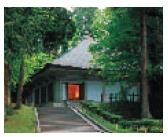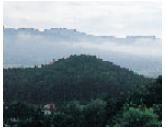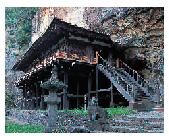The medieval scenery depicted in the Mutsu no Kuni Honederamura Ezu pictorial map still remains today, after hundreds of years. The Cultural Heritages of Hiraizumi, including the Honedera Village Estate Site registered as a UNESCO World Heritage Site in 2011.
Honedera Village Estate is one of the Cultural Heritages of Hiraizumi. Honedera Village Estate Site (national historic site; important cultural landscape, 2nd site to be designated so in the country), located in the Hondera area of Gembi-cho, Ichinoseki, still lives on among people’s lives.
Honedera Village Estate Site and Rural Landscape (Gembi-cho, Ichinoseki)

Jizaibo Renko devoted himself to the completion of Gold-and-Silver Canon. It is said that, when he was appointed as the first Scripture House Attendant by Fujiwara no Kiyohira, he donated his private property Honedera Village to the Scripture House. From then until the Muromachi period, Honedera Village served as the Scripture House and maintained its scenic appearance. The scenery is depicted in the Mutsu no Kuni Honederamura Ezu drawing, and its medieval estate landscape still remains today, (approx. 20 min. by car from Ichinoseki I.e.; approx. 30 min. by car from JR Ichinoseki Station)
Chuson-ji Temple (Hiraizumi)
Chuson-ji is said to have been established in 850 by Jikaku Daishi, a Buddhist abbot, as the headquarter of the Tendai Sect. Later on, Fujiwara no Kiyohira worked on the redevelopment of Chuson-ji, building over 40 temple towers and a large temple with over 300 monks, symbolizing the prosperity of the Hiraizumi Culture. Much of Chuson-ji has been destroyed by fire, but Konjikido, or the Golden Hall, as well as over 3000 national treasures and important cultural assets still remain, making it a treasury of Heian Buddhist art.
Explanation for the Photographs of Chuson-ji Temple (Hiraizumi)
- Honedera Village Estate Site aerial photograph
- Mutsu no Kuni Honederamura Ezu pictorial map at Chuson-ji Temple Daichojuin
- Chuson-ji Erection Memorial Service Prayer (part) Kitabatake Akiie at Chuson-ji Temple Daichoju-in
- and Jizaibo Renko portrait at Chuson-ji Temple Daichoju-in

Motsu-ji Temple (Hiraizumi)

Like Chusonji, Motsu-ji is said to have been established by Jikaku Daishi in 850. The Pure Land garden, with Oizumigaike Pond in the center, remains almost unchanged since the Heian period. Its development was begun by the second Oshu Fujiwara lord, Motohira, and completed by his son and heir, Hidehira. In its time the size of Motsu-ji even surpassed that of Chuson-ji. Every May, Gokusui no En Festival, a poetry contest popular in the Heian period, is held.
Muryoko-in Temple Site (Hiraizumi)
This temple was built in the style of the Phoenix Hall (Hoodo) of Uji’s Byodo-in, outside of Kyoto, by the third lord Hidehira; like Byodo-in, it had Amida Nyorai (Skt. Amitabh) enshrined as its main image of worship. Sadly, the area has been almost completely consumed by fire and has been turned into rice paddies, and only the pond site, mid island, and cornerstones remain; nonetheless, it is designated as a national special site.
Mt. Kinkei (Hiraizumi)

Hidehira, the third lord of the Fujiwara clan, had this mountain made, designed after Mt. Fuji. Its name, which means “gold chicken mountain,” comes from the legend that a male-female pair of gold chickens (a symbol of rebirth) was buried at its peak as protectors of the city. In the Senjudo Hall near the mountain entrance are the posthumous memorial tablets of the three Fujiwara lords and a wooden statue of Hidehira; behind the Hall are the tombs of Minamoto no Yoshitsune’s wife Kita no Kata and their daughter.
Yanagi no Gosho Site (Hiraizumi)
Yanagi no Gosho Site is a vast area that covers about 100,000 m2 of the western bank of the Kitakami River. Ruins of pillars, mansions, and ponds have been found in excavations, suggesting that Yanagi no Gosho was the governmental center of Hiraizumi, Hiraizumi no Tachi. Precious finds, such as the first seal in Japan, are displayed in the nearby Yanagi no Gosho Museum.
Takkoku no Iwaya Cave temple (Hiraizumi)

When barbarian-conquering generalissimo Sakanoue no Tamuramaro crushed local resistance, led by King Akuro-O, to imperial rule in 801, he enshrined 108 statues of Bishamon (Skt. Vaisravana), protector of the north and the Buddhist law. Unfortunately, most of the statues have been destroyed by fire, and the building which stands today was rebuilt in 1961. The Dainichi Nyorai Statue (Skt. Mahavairocana), carved in the rock wall to the west of the building, is the northenmost of its kind on Honshu Island.
Shirotoritate Mansion Site (Maesawa-ku, Oshu)

This site is thought to have originally been a residence of Shirotori Hachiro Norito, the eighth son of Abe no Yoritoki. Surrounded about 270 degrees by the Kitakami River, it served as a major transportation artery and a stronghold, and contributed greatly to Hiraizumi’ s prosperity for about 600 years, from the tenth to the sixteenth century.
Chojagahara Haiji Site (Koromogawa-ku, Oshu)
 To the south of this site is Mt. Kanzan on which Chuson-ji Temple was built; to the east is Mt. Tabashineyama which was admired by the Buddhist monk Saigyo. It is a square surrounded by roofed mud- walls, about 100 meters on each side, with sites of the South Gate, Main Temple, and West Tower. This is a temple site dating back to the reign of the Abe clan, ancestors of the Oshu Fujiwara clan who would later establish Hiraizumi.
To the south of this site is Mt. Kanzan on which Chuson-ji Temple was built; to the east is Mt. Tabashineyama which was admired by the Buddhist monk Saigyo. It is a square surrounded by roofed mud- walls, about 100 meters on each side, with sites of the South Gate, Main Temple, and West Tower. This is a temple site dating back to the reign of the Abe clan, ancestors of the Oshu Fujiwara clan who would later establish Hiraizumi.

Location and Contact Information:
Honedera Regional Development Council
Wakagamiko 241-2, Gembi-cho, Ichinoseki City (Ichinoseki-shi), Iwate Prefecture (Iwate-ken) 021-0101 Japan [Geo Coordinate: 38.972155219352544, 140.96089839935303] TEL/FAX: 0191-33-5022
Honedera Regional Development Council Website: http://www.honedera.jp
Honederamura Shoen Iseki: http://www.city.ichinoseki.iwate.jp/index.cfm/7,22660,113,html
The History of Honedera-mura: a video illustration with English Subtitles: http://www.honedera.jp/outline/movie.html
Honedera Village (Honedera-mura) Shoen Iseki and Rural Landscape: http://www.pref.iwate.jp/~hp0907/english/syokai/honederamura.html
Walking In and Around Hiraizumi: http://www.pref.iwate.jp/~hp0907/english/guidemap.pdf
Hiraizumi Tourism Association (Hiraizumi Tourist Information Center)
61-7 Izumiya, Hiraizumi, Hiraizumi town (Hiraizumi-cho), Nishiiwai District (Nishiiwai-gun), Ichinoseki City (Ichinoseki-shi), Iwate Prefecture (Iwate-ken) 029-4102 Japan [Geo Coordinate: 38.988334999999999,141.11724999999998] Note: The Hiraizumi town lost some land to the city of Ichinoseki from September 1, 1956 to May 1, 1964. Tel: 0191-46-2110 Fax: 0191-46-2117
Website: http://hiraizumi.or.jp/en/index.html
Hiraizumi World Heritage Promotion Office (Hiraizumi Cultural Heritage Center)
44 Hanadate, Hiraizumi, Iwate, Japan 029-4192 TEL: 0191-46-2218
E-mail: seka…@town.hiraizumi.iwate.jp
Website: http://www.town.hiraizumi.iwate.jp/hiraizumi/english/index.html
Iwate Hiraizumi Interpreters and Guides Association
Provide nationally and regionally certified interpreter-guides for your visit to Hiraizumi Cultural Heritage sites as well as to Morioka & its environs, the Hachimantai area, Tono area and Sanriku-kaigan Coast area. Address: 208 Aza Hanadate, Hiraizumi, Hiraizumi Town, Nishiiwai-gun, Iwate-ken, Japan 029-4102 TEL : 0191-46-5710 (9:00~16:00) FAX : 0191-46-3518
E-MAIL: info…@iwate-guide.sakura.ne.jp
Website: http://iwate-guide.sakura.ne.jp/en/en01.html
Chuson-ji Temple
202 Koromonoseki, Hiraizumi, Iwate 029-4102 TEL. 0191-46-2211 Hiraizumi Guided Tours(Chusonji): Tel. 0191(46)4203 FAX. 0191-46-2216
Website: http://www.chusonji.or.jp/en/index.html
Motsuji Temple
Osawa, Hiraizumi, Iwate 029-4102 Hours: 8:30-17:00 daily (11/5-4/4: 8:30-16:30) Tel: +81-191-46-2331
Website: http://www.motsuji.or.jp/english/index.php
Related Links:
Hiraizumi – Listed in the UNESCO World Heritage List: http://whc.unesco.org/en/list/1277
Hiraizumi Town Website: http://www.town.hiraizumi.iwate.jp/
Ichinoseki City Museum: http://www.museum.city.ichinoseki.iwate.jp/icm/index.html






